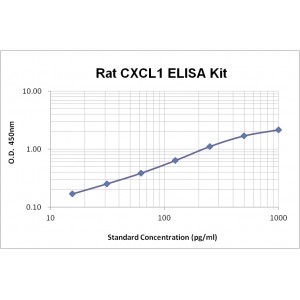More info
Assay Range | 15.6-1,000 pg/mL |
Sensitivity | 1.0 pg/mL |
Size | 96T |
Storage | Store at 2 - 8ºC. Keep reconstituted standard and detection Ab at -20 ºC |
Assay Principle | Sandwich ELISA |
Sample Volume | 100 µL final volume, dilution factor varies on samples |
Detection Method | Chromogenic |
Kit Components
1. Recombinant Rat CXCL1 standard: 2 vials
2. One 96-well plate coated with anti- Rat CXCL1 Ab
3. Sample diluent buffer: 12 mL - 1
4. Detection antibody: 130 µL, dilution 1:100
5. Streptavidin-HRP: 130 µL, dilution 1:100
6. Antibody diluent buffer: 12 mL x1
7. Streptavidin-HRP diluent buffer: 12 mL x1
8. TMB developing agent: 10 mL x1
9. Stop solution: 10 mL x1
10. Washing solution (20x): 25 mL x1
Background
CXCL1 (chemokine C-X-C motif ligand 1), also known as growth-regulated alpha protein, GRO-alpha, melanoma growth stimulatory activity (MGSA), or neutrophil-activating protein 3 (NAP-3), is a small cytokine belonging to the CXC chemokine family. Rat CXCL1, or called as Cytokine-Induced Neutrophil Chemoattractant-1 (CINC-1), CINC, rat GROα, and rat KC, is synthesized as a 96 amino acid (aa) precursor containing a 24 aa signal peptide and a 72 aa mature segment with two intrachain disulfide bonds, an ELR and CXC motif. In the mature region, rat CXCL1/CINC-1 shows 66% and 70% aa sequence identity to rat CINC-2α and CINC-3, respectively. It shares 92% and 69% aa sequence identity to mouse KC (CXCL1) and human CXCL1, respectively. In human, CXCL1 is expressed in monocytes, fibroblasts, melanocytes, mammary epithelial cells, and umbilical vein endothelial cells, it is induced by a variety of inflammatory mediators or growth factors, such as IL-1, TNF and PDGF. Expression of rat CXCL1 is induced by IL-1β, TNF-α and bacterial products in various cell types including hepatocytes, mast cells, macrophages, neurons, Kupffer cells, fibroblasts, type II greater alveolar cells, and cardiac muscle cells. CXCL1 binds with high affinity to the type II IL-8 receptor IL-8 RB, while it binds with low affinity to the type I IL-8 receptor IL-8 RA. Recently, it has been shown that CXCL1 elicits its effects by interacting with the chemokine receptor CXCR2. CXCL1 is a potent chemoattractant for human neutrophils and stimulates neutrophil degranulation and enzyme release from cytochalasin B-treated human neutrophils. It is shown that CXCL1 plays a role in spinal cord development by inhibiting the migration of oligodendrocyte precursors and is involved in the processes of angiogenesis, inflammation, wound healing, and tumorigenesis. CXCL1 appears to induce an acute inflammatory reaction when injected into the foot-pads of endotoxin resistant mice. Rat CXCL1 functions as a major neutrophil chemoattractant and activator to promote neutrophil rolling and adhesion, as well as direct neutrophils to sites of bacterially-induced inflammation.


